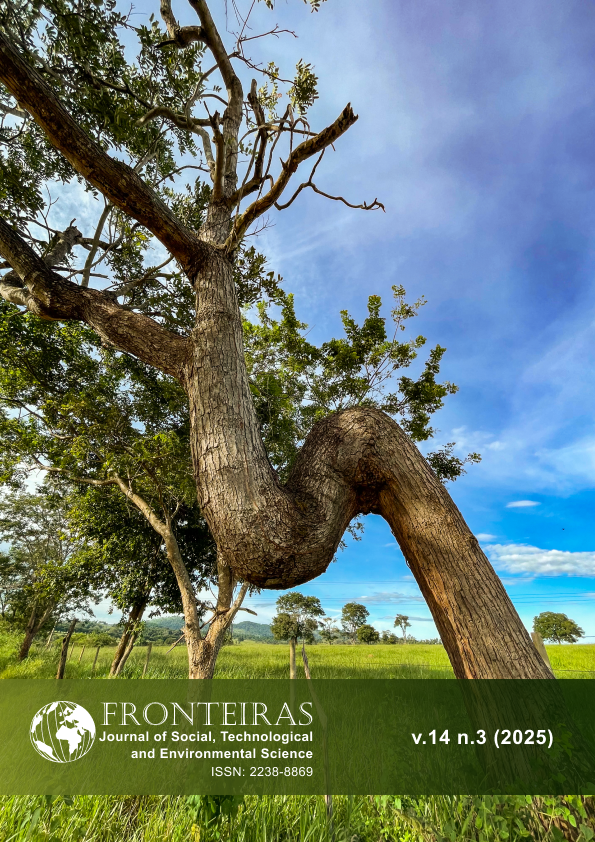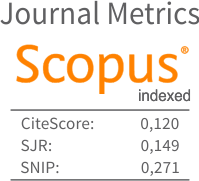Distribuição Temporal e Espacial de Populações de Guarás (Eudocimus ruber Linnaeus, 1758) e Colhereiros (Platalea ajaja Linnaeus, 1758) no Estuário de Guaraqueçaba - PR
DOI:
https://doi.org/10.21664/2238-8869.2025v14i3.7974Keywords:
protected areas, conservation, Atlantic Forest, scarlet ibises, roseat spoonbillsAbstract
This study aimed to analyze the temporal and spatial distribution of Scarlet Ibises (Eudocimus ruber) and Roseate Spoonbills (Platalea ajaja) in the Guaraqueçaba estuary, located on the northern coast of Paraná, Brazil. The purpose was to provide ecological data on these species and to understand how the presence of a balanced environment influences their permanence in the region. Additionally, the study sought to highlight the importance of local Protected Areas (PAs) in the conservation of these coastal birds. The municipality is part of one of the largest remaining areas of Atlantic Forest and includes an estuarine complex with a mosaic of PAs, such as Superagui National Park and the Guaraqueçaba Ecological Station, which support diverse ecosystems and threatened species. Data collection was conducted during five expeditions between August 2018 and June 2019, along four boat-based transects. Both species were recorded in all sampling months, showing seasonal variations in abundance. A total of 1,202 Scarlet Ibises and 91 Roseate Spoonbills were recorded. Scarlet Ibises were most abundant in August 2018 (563 individuals) and April 2019 (405 individuals), while Spoonbills peaked in October 2018 (54 individuals). Spatially, Ibises were mainly concentrated in the Tibicanga and Guapicum regions, near PAs. Spoonbills, in contrast, showed a broader distribution, from Tromomô to the Varadouro Channel. Both species exhibited an aggregated distribution pattern, but were not observed coexisting at the same sites, suggesting interspecific competition or distinct ecological strategies. Scarlet Ibises showed higher frequency of occurrence during months with lower rainfall (August and April – 100%), whereas Spoonbills had their highest frequency in October, a month with high precipitation. These findings reinforce the ecological importance of the Guaraqueçaba estuary and emphasize the urgent need for integrated conservation strategies and environmental education efforts to mitigate human impacts and ensure the protection of local biodiversity.
References
ALEIXO A & VIELLIARD ME 1995. Composição e dinâmica da avifauna da Mata de Santa Genebra, Campinas - São Paulo, Brasil. Revista Brasileira de Zoologia, Campinas, 12(3):493-511.
ALHO CJR, SILVA JSV 2012. Effects of severe floods and droughts on wildlife of the Pantanal wetland (Brazil): a review. Animal, Suíça, 2(4): 590-610.
ANTAS PTZ, PALO JR H 2004. Pantanal: guia de aves: espécies da Reserva Particular do Patrimônio Natural do SESC Pantanal. Departamento Nacional; SESC, Rio de Janeiro, 249 pp.
BALL TS, BALMFORD B, BALMFORD A, RINALDO D, VISCONTI P, GREEN, R 2024. A general relationship between population size and extinction risk. arXiv preprint arXiv: 2411.
BARBIERI E 2009. Sítios de alimentação frequentados pelo Guará (Eudocimus ruber) no estuário de Cananéia-Ilha Comprida, São Paulo. Ornitologia Neotropical 20(1): 73-79.
BRASIL. Decreto n° 97.688, de 25 de abril de 1989. Cria no Estado do Paraná, o Parque Nacional do Superagui e dá outras providências. Diário Oficial da República Federativa do Brasil, Brasília, DF, 26 abr. 1989. Seção 1, p. 6417.
BRASIL. Lei n° 9.513, de 20 de novembro de 1997. Amplia os limites do Parque Nacional do Superagui. Diário Oficial da República Federativa do Brasil, Brasília, DF, 21 nov. 1997. Seção 1, p. 27181.
BRASIL. Lei n° 9.985 de 18 de julho de 2000. Institui o Sistema Nacional de Unidades de Conservação da Natureza. Diário Oficial da República Federativa do Brasil, Brasília, DF, 19 jul. 2000. Seção 1, p. 1.
BRASIL. MINISTÉRIO DO MEIO AMBIENTE 2022. Portaria n° 148 de, de 7 de junho de 2022. Diário Oficial da União, Brasília, DF, p. 74, 7 jun. 2022.
BRASIL. Ministério do Meio Ambiente. Cadastro Nacional de Unidades de Conservação - CNUC. Lei n° 9.985/2000. Tabela Consolidada das Unidades de Conservação, 2023. Brasília: Ministério do Meio Ambiente, 2023.
CABRAL BLF 2015. Entre marés: pesca artesanal e náutica na Baía de Guaratuba. Dissertação de Mestrado em Meio Ambiente e Desenvolvimento, Universidade Federal do Paraná, Curitiba (PR), 145 f.
CHUPIL H & MONTEIRO-FILHO ELA 2018. History of the scarlet ibis Eudocimus ruber in the south and south-east Brazil. Bulletin of the British Ornithologist’s Club, 138(4): 281-285.
CORRÊA F 1996. A reserva da biosfera da Mata Atlântica: Roteiro para o entendimento de seus objetivos e seu sistema de gestão. Vol. II, UNESCO, São Paulo, 27pp.
DUDLEY N, editor 2008. Guidelines for applying Protected Area Management Categories. IUCN, Gland, Switzerland, 85pp.
FINK D & CREMER MJ 2015. The return of the scarlet ibis: first breeding event in southern Brazil after local extinction. Revista Brasileira de Ornitologia, 23(4): 385-391.
FREDERICK PC 2002. Wading birds in the marine environment. In BURGER J & SCHREIBER EA. Biology of marine birds. CRC Press, Boca Raton,p, 618-655.
FUNDAÇÃO SOS MATA ATLÂNTICA & INPE. Atlas dos remanescentes florestais da Mata Atlântica no período de 2020-2021. Relatório técnico. São Paulo, 2022.
GASTON KJ, BLACKBURN TM, GREENWOOD JJD, GREGORY RD, QUINN RM & LAWTON JH 2000. Abundance-occupancy relationships. Journal of Applied Ecology, 37(1): 39-59.
GONÇALVES EC, FERRARI SF, BURLAMAQUI TC, MIRANDA L, SANTOS MS, SILVA A & SCHNEIDER MPC 2010. Genetic diversity and differentiation of three brazilian populations of scarlet ibis (Eudocimus ruber). Journal of Ornithology, 151(4): 797-803.
GROSE AV 2016. O guará Eudocimus ruber (aves: Threskiornithidae) no estuário da Baía da Babitonga, litoral norte de Santa Catarina: repovoamento, distribuição e biologia. Tese de Doutorado, Universidade Federal do Paraná, Curitiba.
HASS A 1996. Biologia comportamental de Eudocimus ruber (Aves, Threskiornithidae) em manguezais da Ilha do Cajual, Maranhão: reprodução e alimentação. Dissertação de Mestrado, Universidade Estadual de Campinas, Campinas, 91 pp.
INSTITUTO DE DESENVOLVIMENTO RURAL DO PARANÁ - IAPAR-EMATER. Dados meteorológicos históricos e atuais. 2022.
IPARDES 1989. APA de Guaraqueçaba: caracterização sócio-econômica dos pescadores e pequenos produtores rurais. Curitiba, Brasil, IPARDES, 87pp.
IUCN 2023. The IUCN Red List of Threatened Species. Version 2022-2.
JOLY CA, METZGER JP, TABARELLI M 2014. Experiences from the Brazilian Atlantic Forest: ecological findings and conservation initiatives. New Phytologist, 204(3): 459-473.
KUSHLAN JA 1993. Colonial waterbirds as bioindicators of environmental change (review). Waterbirds Society, 2(1): 83-97.
LEUZINGER MD, GODOY LR da C, FERNANDES MHC 2014. Estações Ecológicas e Reservas Biológicas: pesquisa e preservação. UniCEUB, Brasília, 235 pp.
MARCONDES-MACHADO LO & MONTEIRO-FILHO ELA 1990. The scarlet ibis Eudocimus ruber in southeastern Brazil. Bulletin of the British Ornithologist’s Club, 110(1): 123-126.
MARTINS PTA & WANDERLEY LL 2009. Dinâmica de ocupação de áreas contíguas (período 1987-2008) e sua relação com tensores de origem antrópica no manguezal do Rio Cachoeira, Ilhéus, Bahia. Sociedade & Natureza, 21(2): 77-89.
MARTINS MC 2015. Monitoramento das interações entre boto-cinza e as embarcações no complexo estuarino lagunar de Cananéia-SP. Dissertação de Mestrado em Ciências Biológicas, Setor de Ciências Biológicas, Universidade Federal do Paraná, Curitiba (PR), 53 f.
MATHEUS P & DEL HOYO J 1992. Family Threskiornithidae. In J DEL HOYO, ELLIOT A and SARGATAL J, editors. Handbook of the world Birds: Ostrich to ducks. Lynx Ediciones, Barcelona, p. 472-506.
MORSE DH 1974. Niche breadth as a function of social dominance. American Naturalist. 108(964): 818-830.
NOGUCHI RG 2011. Distribuição e abundância dos Guarás, Eudocimus ruber Linnaeus, 1758 (Ciconiiformes: Threskiornithidae) no complexo estuarino lagunar de Iguape/Cananéia, Estado de São Paulo. Trabalho de Conclusão de Curso (Bacharel em Ciências Biológicas), Universidade Federal do Paraná, Curitiba.
OLIVEIRA TCG 2009. Diversidade de espécies e comportamento de uma comunidade de aves estuarinas em um baixio no Lagamar de Cananéia, litoral sul do Estado de São Paulo, Brasil. Tese de Doutorado, Universidade Federal do Paraná, Curitiba, 129f.
OLMOS F, SILVA E SILVA R, PRADO A 2001. Breeding season diet of Scarlet Ibises and Little Blue Herons in a Brazilian mangrove swamp. Waterbirds: The International Journal of Waterbird Biology, 24(1): 50-57.
PACHECO JF, SILVEIRA L.F, ALEIXO A, AGNE CE, BENCKE GA, BRAVO G.A, BRITO GRR, COHN-HAFT M, MAURÍCIO GN, NAKA LN, OLMOS F, POSSO S, LEES AC, FIGUEIREDO LFA, CARRANO E, GUEDES RC, CESARI E, FRANZ I, SCHUNCK F & PIACENTINI VQ 2021. Annotated checklist of the birds of Brazil by the Brazilian Ornithological Records Committee - second edition.Ornithology Research, 29(2): 1-123.
PALUDO D, CAMPOS FP, COLLAÇO FL, FRACASSO HAA, MARTUSCELLI P & KLONOWSKI VS 2018. Reproduction of Eudocimus ruber in the Iguape - Cananéia - Ilha Comprida estuary complex, São Paulo, Brasil. Atualidades Ornitológicas, 202(1): 8-15.
PINHEIRO MAA, COSTA TM, GADIG OBF & BUCHMAN FSC 2008. Os ecossistemas costeiros e sua biodiversidade na Baixada Santista. In Oliveira AJFC, Pinheiro MAA, Fontes RF. Panorama Ambiental da Baixada Santista. Universidade Estadual Paulista - Campus Experimental do Litoral Paulista, São Vicente, p. 7-26.
PIZZO MA & GALETTI M 2010. Métodos e Perspectivas da Frugivoria e Dispersão de Sementes por aves. In Matter SV, Straube FC, Accordi LA, Piacentini VQ, Cândido FJ. Ornitologia e conservação: ciência aplicada, técnicas de pesquisa e levantamento. Roca, São Paulo, p. 493-506.
PODULKA S, ROHRBAUGH JRW, BONEY R, editors. 2004. Handbook of Birds Biology. Cornell Lab of Ornithology, 2° edição Ithaca, Nova York, p. 225.
REZENDE CL, SCARANO FR, ASSAD ED, JOLY CA, METZGER JP, STRASSBURG BBN, TABARELLI M, FONSECA GA, MITTERMEIER RA 2018. From hotspot to hopespot: An opportunity for the Brazilian Atlantic Forest. Perspectives in Ecology and Conservation, Rio de Janeiro,16(4): 208-214.
RODRIGUES AAF 1995. Ocorrência da reprodução de Eudocimus ruber na ilha do Cajual, Maranhão, Brasil (Ciconiiformes: Threskiornithidae). Ararajuba, 3(3): 67-68.
ROSELLI LY, BARBIERI E 2022. Seasonal variation of estuarine birds from Trapandé Bay, Cananéia, Brazil. Ocean and Coastal Research, 70.
SALVIO GMM, SANTOS EF, BATISTA JC, TEIXEIRA AL, SILVEIRA JÚNIOR WJ 2015. Distribuição temporal e espacial de uma população de guarás (Eudocimus ruber) no estuário de Guaraqueçaba, Paraná. In XII Congresso de Ecologia do Brasil, São Lourenço, 2015. Anais… São Lourenço, CEB.
SANTINI L, ISAAC NJB, HUIJBREGTS MAJ, FICETOLA GF, CARBONE C & THUILLER W 2022. Population density estimates for terrestrial mammal species. Global Ecology and Biogeography, 31(4), 716-726.
SICK H 1997. Ornitologia Brasileira. Editora Nova Fronteira. Rio de Janeiro, 912 pp.
SILVA E SILVA R 2007. Guarás vermelhos no Brasil: as cores vibrantes da preservação. Avisbrasilis,São Paulo, 240 pp.
SILVA RRS, MORETE CN, MASO M 2012. Estudo e composição da avifauna do Campus da Fafram-Ituverava, SP. Nucleus, 9(2): 301-312.
SOUZA CA, DUARTE LFA, JOÃO MCA & PINHEIRO MAA 2018. Biodiversidade e conservação dos manguezais: importância biológica e econômica. In Pinheiro MAA & Talamoni ACC (Org.). Educação Ambiental sobre Manguezais. UNESP, Instituto de Biociências, Campus do Litoral Paulista, São Vicente, p. 16-55.
SOUZA RM de 2014. As singularidades cênicas do Litoral Paranaense: Um olhar sobre a Paisagem Cultural de Guaraqueçaba (PR). Tese de Doutorado em Geografia, Universidade Estadual de Maringá, Maringá, 204 pp.
STOTZ DF, FITZPATRICK JW, PARKER TA & MOSKOVITS DK 1996. Neotropical birds: ecology and conservation. University of Chicago Press, Chicago, Environmental Conservation 23(4): 381-381.
STRAUBE FC 2011. Ruínas e urubus: história da ornitologia no Paraná. Período Pré-Nattereriano (1541 a 1819). Vol. III(1), Hori Consultoria Ambiental, Curitiba, p. 195.
TABARELLI M, SGUIAR AV, RIBEIRO MC, METZGER JP, PERES CA 2010. Prospects for biodiversity conservation in the Atlantic Forest: lessons from aging human-modified landscapes. Biological Conservation, 143(10): 2328-2340.
TÁBUA DE MARÉS. Preia-Marés de Baía de Paranaguá. 2018.
VIGÁRIO DC, KRUL R & SPACH HL 2020. Ecologia de Eudocimus ruber (Pelecaniformes, Threskiornithidae) no litoral do estado do Paraná, Brasil. Oecologia Australis, 24(4): 964-970.
ZANIN GR, TOSIN LF & BARBIERI E 2008.Influência da maré na abundância de Egretta caerulea (Linnaeus, 1758) em uma enseada estuarina da Ilha Comprida, São Paulo, Brasil. Estudos de Biologia, Ambiente e Diversidade, 30(70/72): 133-139.
Downloads
Published
How to Cite
Issue
Section
License
Copyright (c) 2025 Matheus Felipe da Costa Pereira, Carolina Ribeiro Gomes, Guilherme Oliveira Teixeira de Carvalho, Geraldo Majela Moraes Salvio

This work is licensed under a Creative Commons Attribution-NonCommercial 4.0 International License.
This journal offers immediate free access to its content, following the principle that providing free scientific knowledge to the public, we provides greater global democratization of knowledge.
As of the publication in the journal the authors have copyright and publication rights of their articles without restrictions.
The Revista Fronteiras: Journal of Social, Technological and Environmental Science follows the legal precepts of the Creative Commons - Attribution-NonCommercial-ShareAlike 4.0 International. 


